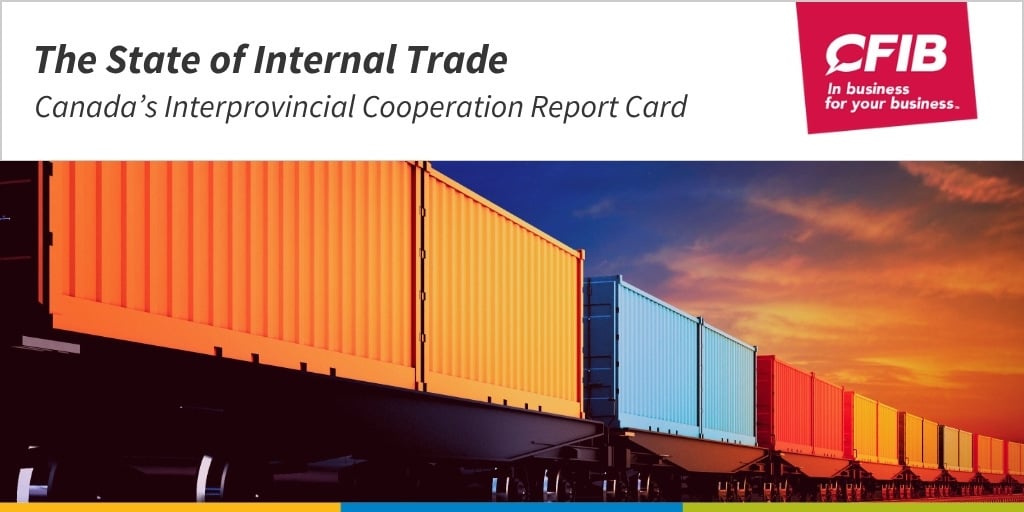
The 2025 edition of the report card grades federal, provincial, and territorial governments' interprovincial cooperation efforts and provides an overview of the work done to reduce the barriers to internal trade. It offers a snapshot of the progress made and highlights the challenges faced by governments in achieving a more prosperous and integrated union.
This report card continues to grade three major areas of interprovincial/territorial cooperation:
- Canadian Free Trade Agreement (CFTA) exceptions,
- the existence of inter-jurisdictional barriers to internal trade, and
- the implementation status of items from reconciliation agreements.
This year’s report card includes a new bonus indicator aiming to recognize and reward jurisdictions that have taken up CFIB’s 2022 challenge to implement mutual recognition for goods, services, and labour.
Within this framework, governments with the highest overall report card scores are those that have the fewest exceptions and have made the most progress towards reducing specific barriers, or have fully legislated and implemented mutual recognition. Nova Scotia receives the highest overall score of 9.4 (A grade) in the report card, followed by Ontario with a score of 9.2 (A grade), (see Table 1).
No jurisdiction receives a perfect overall score of 10 indicating that work still remains to be done to reduce internal trade barriers.
| Jurisdiction | I. Canadian Free Trade Agreement Exceptions (40%) | II. Select Barriers to Internal Trade (20%) | III. Status of Items from Reconciliation Agreements (40%) | Bonus Indicator: Mutual Recognition (Multiplier) | Overall Score and Grade | ||||
|---|---|---|---|---|---|---|---|---|---|
| NS | 2.3 | F | 5.9 | D | 8.9 | A- | 8.5 | 9.4 | A |
| ON4 | 10 | A+ | 6.0 | C- | 8.2 | B | 5 | 9.2 | A |
| MB | 7.3 | C+ | 5.4 | D | 9.6 | A | 5 | 8.9 | A- |
| BC | 6.3 | C- | 4.1 | D | 9.2 | A | 5 | 8.5 | B+ |
| FED3 | 6.8 | C | 9.7 | A | 0 | 8.2 | B | ||
| AB | 7.9 | B | 4.1 | D | 9.5 | A | 1 | 8.0 | B |
| PE | 3.1 | F | 4.7 | D | 8.8 | A- | 5 | 7.8 | B |
| SK | 6.8 | C | 5.3 | D | 9.2 | A | 1 | 7.7 | B- |
| NB | 4.8 | D | 4.7 | D | 8.5 | B+ | 1 | 6.6 | C |
| QC | 0.0 | F | 3.6 | F | 8.9 | A- | 3 | 6.0 | C- |
| NL | 4.1 | D | 2.6 | F | 8.5 | B+ | 1 | 6.0 | C- |
| NT | 4.8 | D | 2.0 | F | 8.8 | A- | 0 | 5.8 | D |
| NU | 4.5 | D | 2.0 | F | 8.6 | B+ | 0 | 5.6 | D |
| YT | 1.3 | F | 3.0 | F | 8.8 | A- | 0 | 4.6 | D |
- Score: 10 is best, 0 is worst. The scores of the three areas of interprovincial/territorial cooperation are combined into a single score that allows for a ranking of governments from best (highest score) to worst (lowest score).
- Grade: A, A-: 8.7-10 (Excellent performance); B+, B, B-: 7.5-8.6 (Good performance); C+, C, C-: 6.0-7.4 (Satisfactory performance); D: 4-5.9 (Less than satisfactory performance); F: 0-3.9 (Unsatisfactory performance).
- The federal government is scored on two areas: economic impact score based on the procurement exceptions they maintain from the CFTA in 2025, and the implementation status of reconciliation agreements. Both areas are weighted equally (50% each) as the select barriers area was not available for this analysis.
- While “A+” is not currently included in the grading scale, Ontario was awarded an A+ in the area of Canada Free Trade Agreement Exceptions for being the first jurisdiction to have no exceptions.
For details on how scores were calculated, refer to the Methodology section in the Appendix F of the report.
Related Documents
| Release Date | Report | Download |
|---|---|---|
| June 2025 | The State of Internal Trade: Canada’s Interprovincial Cooperation Report Card (2025 edition) |
PDF (3.2 MB) |
| May 2025 | Stuck at the border: How paperwork hinders labour mobility for small businesses |
PDF (513 KB) |
| July 2024 | The State of Internal Trade: Canada’s Interprovincial Cooperation Report Card (2024 edition) |
PDF (1.5 MB) |
| June 2023 | The State of Internal Trade: Canada’s Interprovincial Cooperation Report Card (2023 edition) |
PDF (2.4 MB) |
| June 2022 | The State of Internal Trade: Canada’s Interprovincial Cooperation Report Card (2022 edition) |
PDF (1.1 MB) |

 Share Article
Share Article
 Print Article
Print Article
